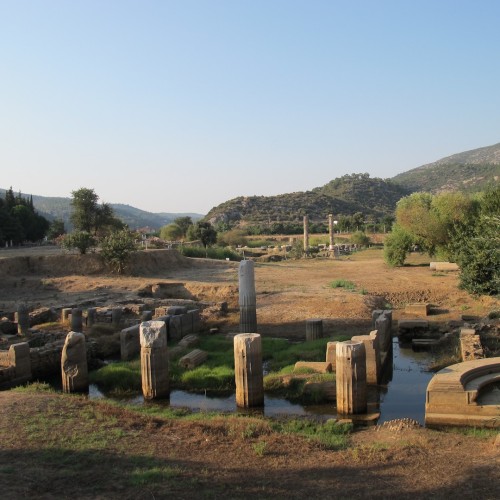
In this blog entry I want to take you away from Istanbul to a beautiful western Anatolian archaeological site near Izmir: Klaros, where I have been working every summer since 2006.

Views from Klaros (photos: Klaros excavation archive)
The sanctuary of Apollo at Klaros is one of the most important oracular centers of the ancient Greek world, where people came to learn about the future and the will of the gods. The site is located within the Ahmetbeyli quarter of the Menderes district, Izmir province, to the south of Cumaovası, in the lower part of the Ahmetbeyli (ancient Ales) Valley, which connects the plain to the Bay of Kuşadası on the south.

Map: Kuşadası Bay, Klaros (googlemaps)
The sanctuary is now located 1.6 km inside the coast line. However, a recent geological study and a coring program in the area have shown that the prior coast line was well inside of today’s coast and formed a long bay at the end of the third millennium BC. The bay began to be filled with alluvium in the second millennium BC, and the sanctuary of Klaros was founded over a marshy area. Klaros had a harbor during its early period. Thukydides describes anchored vessels near Klaros in his account of the Peloponnesian War between the Athenians and Spartans (3.33). The coastline grew further away from Klaros over time due to the silting action of the Ahmetbeyli (Ales, Halysus) River, and its tributary streams, the Kırmızıkayalar and Beynamaz. Klaros stayed buried under thick alluvial deposits for centuries, waiting to be discovered.
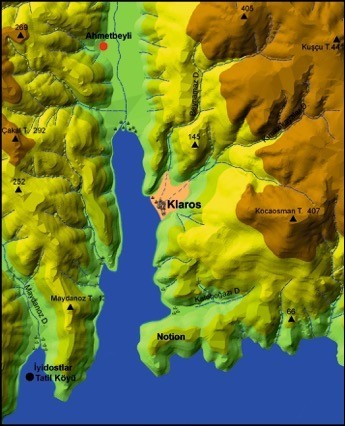
3rd Millennium BC (after Doğan 2008)
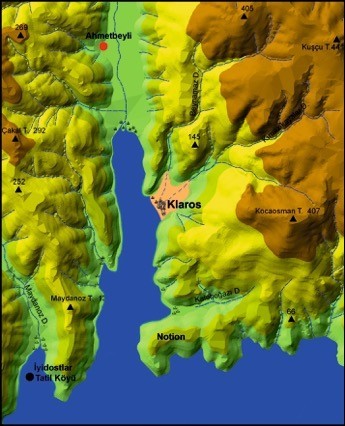
1st Millennium BC (after Doğan 2008)
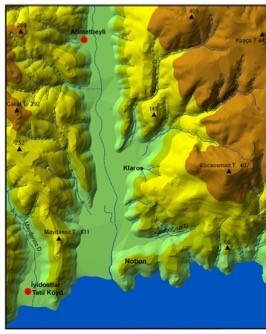
Present Day (after Doğan 2008)
Many travelers, starting with Richard Chandler in 1764, visited this area with the hope of finding the famous oracular center of Apollo. Francis V. J. Arundell in 1826, Charles Texier between 1833 and 1844, Carl Schuchhardt in 1886, and Theodor Macridy in 1904 tried to locate the sanctuary during their trips in Anatolia. Finally, T. Macridy was the one who discovered two columns and the inscribed ante walls of the ‘Propylon’, though he misinterpreted these architectural remains to be part of the temple of Apollo Klarios. Following this discovery,the first systematic investigation at Klaros started in 1913 by T. Macridy and Charles Picard. They revealed the entire ‘Propylon’ during this first excavation season and understood that this structure was not the temple of Apollo, but the entrance building of the sanctuary. They also uncovered the large ‘exedra’ on the east side of the ‘Propylon’ and numbers of inscriptions that were carrying the names of the delegates who came to the sanctuary for consultation mainly in the Late Hellenistic and Imperial period. Their research had to be ceased due to the start of the First World War in 1914. The second period of excavations in the sanctuary took place between 1950 and 1961, led by French epigrapher Louis Robert and his wife Jeanne Robert. Following them, another French scholar, Juliette de La Genière, led the work at Klaros from 1988 to 1997. The last excavation project in the sanctuary was started in 2001 by Nuran Şahin and is still continuing (see Şahin 2012 for detailed information on the research history at Klaros).
After giving a general brief information about the location, geography, and research history of the sanctuary I would like to take you further back to the mythical stories related to the foundation of Klaros.
Although we need to be cautious about accepting the truth of foundation legends, it is still important to consider what ancient authors claimed about the origins of the oracle and also the nearby cities. Pausanias says that “The people of Kolophon suppose that the sanctuary at Klaros, and the oracle, were founded in the remotest antiquity” (7.3.1). According to ancient texts, the establishment of the prophecy center of Apollo Klarios dates back to the 13th century BC (Paus. 7.3.1–2, 9.33.1; Apoll. Rhod. 1.308), which was the period of Achaean colonization of the Kolophonian land. Literary sources inform us that this region witnessed two overseas migrations consecutively in the Bronze Age. Pausanias points out that the locals of the region were Karians and the first migrants to the area had a Cretan origin (7.3.1): “They assert that while the Karians still held the land, the first Greeks to arrive were Cretans under Rhakios, who was followed by a great crowd also; these occupied the shore and were strong in ships, but the greater part of the country continued in the possession of the Karians.”
The second wave of migration to the Kolophonian land supposedly came from Greece (Sakellariou 1958, 345–346; Parke 1985, 119; Şahin 2007, 344). Pausanias informs us that the new arrivals were from the Theban community who had to leave their homeland after the Epigones conquered Thebes (Paus. 7.3.1–2). The captured Thebans were offered to Delphi as slaves. If we accept the accuracy of this story, the Mycenaean pottery found in the destruction level of the palace of Kadmos at Thebes might indicate that this incident took place around 1400–1300 BC (Sakellariou 1958, 347). The prophet of Apollo, Teiresias, and his daughter Manto were said to be among the slaves. Apollo ordered the Thebans to found a colony and Manto to establish a prophecy center in his name specifically in the Kolophonian land. Pausanias states that when Manto and the Theban immigrants arrived at Kolophon, Rhakios was still at war with the locals (Paus. 9.33.1–2). In his narration, Rhakios let the new arrivals settle down and married Manto. She then founded the prophecy center at Klaros following the order of the Delphic Apollo. According to some ancient authors, such as Apollonius of Rhodes, the sacred spring of Klaros was formed by the tears of Manto, who had been expatriated from her country (Apoll. Rhod. 1.308). Nikandros of Kolophon asserts that the name of the sanctuary comes from the Greek ‘kleros’(κλῆρος), which means “share,” and says that Zeus, Poseidon, and Hades shared the universe here. Although the etymology of the prophecy center is disputable, it is the common opinion of ancient writers that its founder was Manto, and the date of the establishment occurred sometime before the Trojan War. Mopsos, the son of Manto and Rhakios, took over the kingship from his father and the task of prophecy from his mother. He was the first priest of Apollo and the king of Kolophonian land who drove the locals inland (Paus. 7.3.1).
After a long period of time, the land of Kolophon may have experienced another migration movement—the Ionian migration—according to the ancient authors. The seventh century BC elegiac poet Mimnermos describes the Pylians’ violent arrival on the Kolophonian coast (Mim. Frag. 9; Strabo 14.1.4): “We left the craggy city of Neleian Pylos, and came on ship to handsome Asia and lovely Kolophon our base. There we brashly mustered our immense army in dreadful pride, and set out along the river flowing inside the forest.” Even though the sanctuary at Klaros has revealed no evidence for the supposed Ionian migration to the land of Kolophon and no information has been found regarding the impact of any migration movements to the prophecy center yet, the recent excavations revealed evidence for the foundation of the sanctuary as early as the 13th century BC. However, due to the physical conditions of the sanctuary it has not been possible to reach the probable Minoan (the first immigrants according to the legends) levels at Klaros. The underground springs and the high level of basement water had been an overwhelming problem for the ancient residents of the sanctuary, and it still causes difficulties for the excavations. We can only say that we have evidence for activity in the sanctuary as early as the 13th century BC.
The earliest architectural remains of cult activity in the sanctuary is the circular altar of Apollo. Material, mainly ceramics, from the circular altar indicates activity during the Late Bronze/Early Iron Age transition period. Numerous animal bones with burnt marks, terracotta bull figurines in various sizes, and ash deposits were found in the area of the circular altar together with Protogeometric and Geometric pottery sherds and material artifacts.
The Archaic period at Klaros shows a change in cult activities with an increase in votive offerings and the emergence of the first temples of Apollo, Artemis, and Leto. Beside the temples a larger rectangular altar for Apollo was built over the earlier circular one, and two smaller altars were erected for Artemis and Leto to the north and the south respectively. This is the period of new trend in building monumental structures in sanctuaries in the Greek world, and Klaros was no different.
The Classical period of the sanctuary reflects the political situation and events in the Greek world. The Persian attacks had an effect on religious places as in all other aspects of life in western Anatolia and the Greek mainland (see Miller 1999). The Archaic structures continued being used for religious rituals in this period and no construction of a new structure seems to have taken place in the sanctuary, except some necessary architectural renovations. The architectural evidence suggests an interruption or recession in the cult, and the decrease in the amount of Classical material supports the argument of a hiatus at Klaros in the fifth century BC due to the Persian attacks.
Following Alexander the Great’s defeat of the Persians, Klaros became famous in the Greek world as an oracular center. Pausanias narrates Alexander’s dream about moving Smyrna to a new spot and sending ambassadors to consult Apollo at Klaros (7.5.1–2): “It is said that Alexander was hunting on Mount Pagos, and that after the hunt was over he came to a sanctuary of the Nemeses, and found there a spring, and a plane-tree in front of the sanctuary, growing over the water. While he slept under the plane-tree, it is said that the Nemeses appeared and bade him found a city there, and to remove into it the Smyrnaeans from the old city. So, the Smyrnaeans sent ambassadors to Klaros to make inquiries about the circumstance, and the god made answer: Thrice, yes for times blest will those men be who shall dwell in Pagos beyond the sacred Meles.”
After the death of Alexander the Great, the sanctuary underwent two extensive construction projects during the rules of Antigonos Monophthalmos (“the one eyed”) in 311–306 BC, and Attalos I in the third century BC, which continued until the end of the life of the sanctuary in the fourth century AD. The construction of the Hellenistic temples of Apollo and Artemis, the altars, the ‘exedrai’, the ‘propoylon’,the honorific monuments, and the hecatomb, which all can be seen at the site today, was started during this period. The Apollo temple was never completed, probably because of its largeness. The cult statues of the Triad—Apollo, Artemis, and Leto—were also erected in the Hellenistic period and are still standing today.
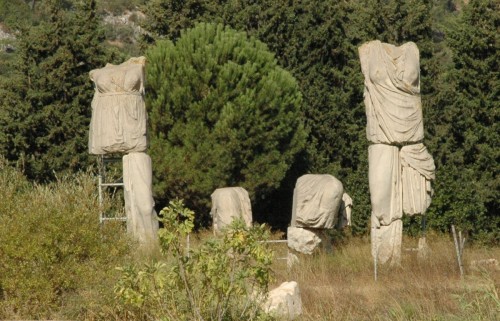
Cult statue group: Artemis, Apollo, and Leto (photo: Klaros excavation archive)
Bibliography
Apollonius Rhodius. ‘Argonautica. LCL’ 1 (edited and translated by W. H. Race), Cambridge, MA: Harvard University Press. 2009.
Mimnermus. ‘Fragments. LCL’ 258. ‘Greek Elegiac Poetry: Tyrtaeus, Solon, Theognis, Mimnermus’, (edited and translated by D. E. Gerber). Cambridge, MA: Harvard University Press. 1999.
Pausanias. ‘Description of Greece I-V: Books 1-10. LCL’ 93, 188, 272, 297–298 (5 volumes), (translated by W. H. S. Jones). Cambridge, MA: Harvard University Press. 2006.
Strabo. ‘The Geography: Books 1–17. LCL’ 49-50, 182, 196, 211, 223, 241, 267 (8 volumes), (translated by H. L. Jones). Cambridge, MA: Harvard University Press. 2005.
Thukydides. ‘History of the Peloponnesian War: LCL’ 9 (translated by C. F. Smith), Cambridge, MA: Harvard University Press. 2005.
Parke, H.W. 1985. ‘The Oracles of Apollo in Asia Minor’. London.
Sakellariou, M.B. 1958. ‘La Migration Grecque en Ionie’. Athens.
Şahin, N. 2007. “Notion-Klaros-Kolophon Üçgeninde Myken Sorunu.” In ‘Patronvs. 65. Yaşında Coşkun Özgünel’e Armağan’, edited by E. Öztepe, M. Kadıoğlu. İstanbul. 329–338.
Şahin, N. “Apollon Klarios Bilicilik Merkezi” In ‘Ege Üniversitesi Arkeoloji Kazıları’, edited by A. Çilingiroğlu, Z. Mercangöz, G. Polat. İzmir. 247–72.

